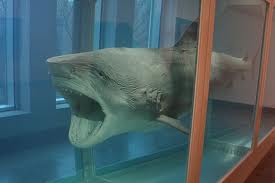The triumph of the man with the shark in formaldehyde . The death of the big idea and its partner in crime the grand narrative has long been acknowledged, with few ordinary folk it would seem shedding any tears for their passing.
Little wonder when it comes to art the major artists tend to look inward rather than attempt to provide explanation for or comment on current issues. Yet does this situation say as much about us as it does about those that have opportunity to provide vision, guidance or insight.
Tate Modern’s announcement of the Damien Hirst retrospective being the most visited solo exhibition in the gallery’s history is one indicator of public expectation.
The exhibition consisting of Hirst trade mark pieces: ‘The physical
impossibility of death in the mind of something living’ which features a shark preserved in formaldehyde; ‘In and out of love’ which uses live butterflies and ‘Pharmacy’ an installation comprising of wall-to-wall medicine cabinets, a receptionist desk and an insecto-O-cutor.
Going by these pieces alone it is difficult to escape the notion that the exhibition is more about showmanship than polemics. Believe it or not, there is comment about our times if credence is given to Hirst’s explanation of his work. What strikes me though is that artists like Hirst have long since recognised that if you have anything to say you need to attract and audience before you can deliver your message.
Whether you like him or loathe him you can’t deny that Hirst has managed to carve out a prime position in the ‘successful living artist’ stakes, doing so by constantly adding fuel to the ‘what’s the purpose of art’ debate.
 This level of success would not be possible without the support of an approving public, not to mention the patronage of wealthy investors. Now I’m not much interested in opinions about the credability of Hirst’s work, for me a debate on the purpose of art is infinitely more fascinating, especially when it comes to art and messages.
This level of success would not be possible without the support of an approving public, not to mention the patronage of wealthy investors. Now I’m not much interested in opinions about the credability of Hirst’s work, for me a debate on the purpose of art is infinitely more fascinating, especially when it comes to art and messages.
Maybe there’s something about the times that we currently live in but there are many people who feel that we no longer face major issues, certainly not of the magnitude that visited a large part of the previous century.
Those who think that way will argue that we have increased social mobility or suggest that equality is not so stifling that campaigns of civil disobedience are still necessary.
Little wonder artists are no longer compelled to produce pieces with the impact of Picasso’s ‘Guernica’ where the message of impending doom was delivered with a well thought out mix of the literal and the metaphorical.
Don’t get me wrong I’m not calling for all artists to put polemics before creativity, and Lord knows there’s been many a poor piece of art produced with just that impulse. Yet I’m concerned that we are all either too self-assured or too pre-occupied to give time or space to big ideas.
Neal Gabler, a Senior Fellow at the University of Southern California is one who
laments the passing of thinking on a grand scale. Neal’s article ‘The elusive big-idea’ sums up why we shouldn’t be so cynical about big ideas: “Ideas just aren’t what they used to be.
Once upon a time, they could ignite fires of debate, stimulate other thoughts, incite revolutions and fundamentally change the ways we look at and think about the world.
They could penetrate the general culture and make celebrities out of thinkers — notably Albert Einstein, but also Reinhold Niebuhr, Daniel Bell, Betty Friedan, Carl Sagan and Stephen Jay Gould, to name a few. The ideas themselves could even be made famous: for instance, for “the end of ideology,” “the medium is the message,” “the feminine mystique,” “the Big Bang theory,” “the end of history.”






